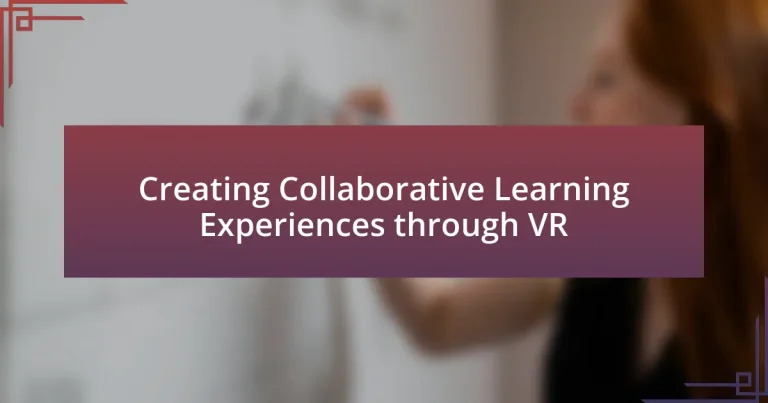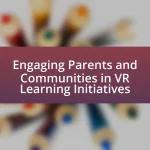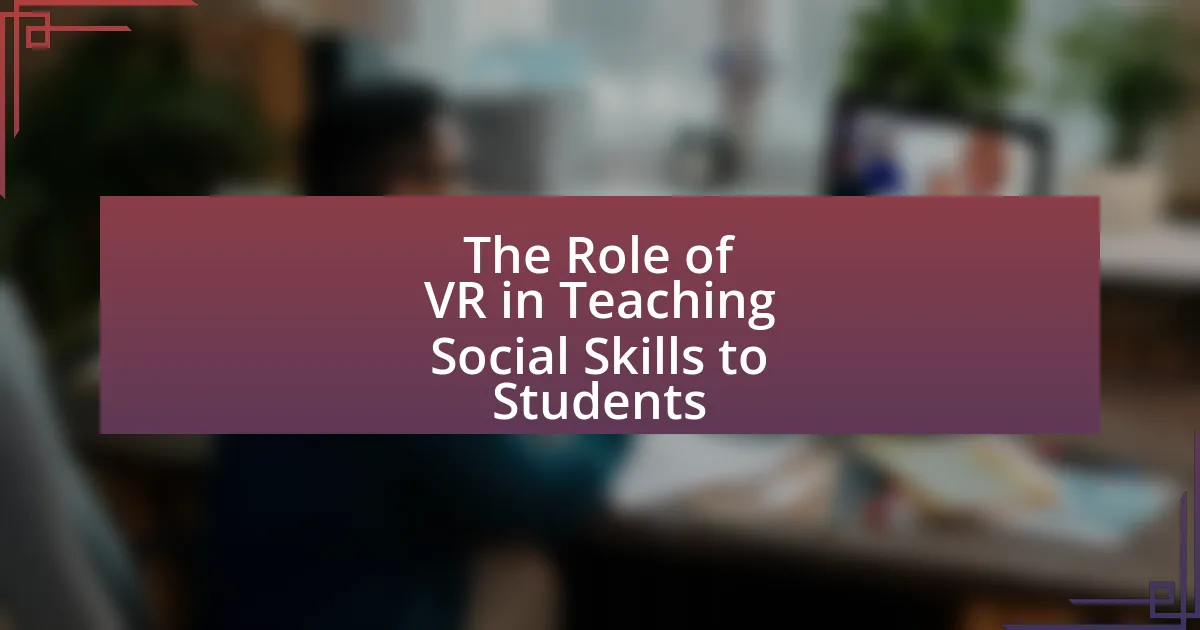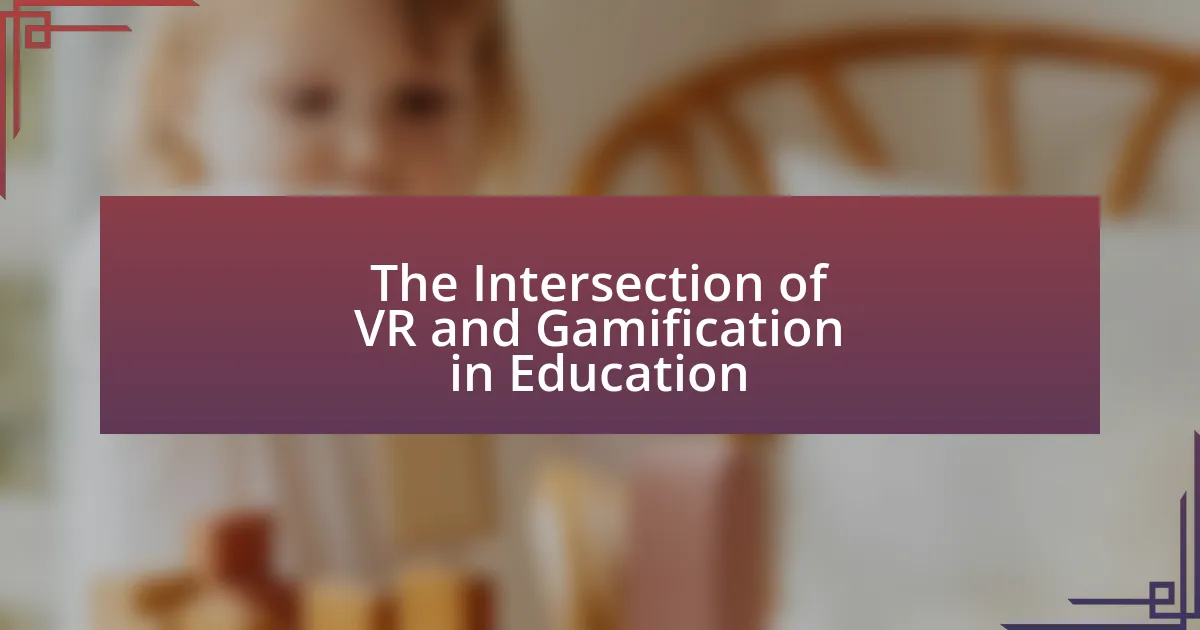Collaborative Learning Experiences in Virtual Reality (VR) are immersive educational interactions that enable multiple users to engage in shared virtual environments, enhancing teamwork, problem-solving, and communication. This article explores how VR technology improves collaborative learning by providing real-time interaction, fostering social presence, and facilitating experiential learning. Key components for effective VR collaborative learning include immersive environments, interactive tools, and user-centered design, while addressing challenges such as technological limitations and accessibility. The article also discusses the importance of feedback, user engagement strategies, and best practices for implementing VR in educational settings to optimize collaborative learning outcomes.

What are Collaborative Learning Experiences in VR?
Collaborative Learning Experiences in VR are immersive educational interactions where multiple users engage in shared virtual environments to learn together. These experiences leverage virtual reality technology to facilitate teamwork, problem-solving, and communication among participants, enhancing the learning process through real-time collaboration. Research indicates that VR can significantly improve engagement and retention in educational settings, as evidenced by a study published in the Journal of Educational Technology & Society, which found that students participating in VR collaborative tasks demonstrated higher levels of motivation and understanding compared to traditional learning methods.
How does VR enhance collaborative learning experiences?
VR enhances collaborative learning experiences by providing immersive environments where learners can interact in real-time, regardless of their physical locations. This technology allows participants to engage in shared tasks, simulations, and problem-solving activities, fostering teamwork and communication skills. Research indicates that VR can increase engagement and motivation among learners, as evidenced by a study published in the Journal of Educational Technology & Society, which found that 85% of students reported improved collaboration in VR settings compared to traditional methods. Additionally, VR facilitates experiential learning, enabling users to practice skills in a safe, controlled environment, which further enhances the collaborative process.
What technologies are essential for VR collaborative learning?
Essential technologies for VR collaborative learning include virtual reality headsets, collaborative software platforms, and motion tracking systems. Virtual reality headsets, such as the Oculus Quest or HTC Vive, provide immersive environments that facilitate interaction among users. Collaborative software platforms, like Spatial or Engage, enable real-time communication and shared experiences within the VR space. Motion tracking systems, including sensors and cameras, enhance user interaction by accurately capturing movements and gestures, thereby enriching the collaborative experience. These technologies collectively create an effective framework for engaging and interactive learning in virtual environments.
How do users interact within a VR collaborative environment?
Users interact within a VR collaborative environment primarily through shared virtual spaces where they can communicate, manipulate objects, and engage in activities together. This interaction is facilitated by avatars representing each user, allowing for non-verbal cues and gestures that enhance communication. Users can utilize voice chat and text messaging to coordinate tasks, share ideas, and provide feedback in real-time. Research indicates that immersive environments significantly improve engagement and collaboration, as evidenced by a study published in the Journal of Virtual Worlds Research, which found that participants in VR settings reported higher levels of social presence and teamwork compared to traditional online platforms.
Why is collaboration important in learning?
Collaboration is important in learning because it enhances critical thinking and problem-solving skills. When learners engage with peers, they are exposed to diverse perspectives, which fosters deeper understanding and encourages the exploration of complex ideas. Research indicates that collaborative learning can lead to improved academic performance; for instance, a study published in the Journal of Educational Psychology found that students who participated in collaborative learning activities scored higher on assessments compared to those who learned individually. This evidence supports the notion that collaboration not only enriches the learning experience but also contributes to better educational outcomes.
What are the psychological benefits of collaborative learning?
Collaborative learning enhances psychological well-being by fostering social interaction, improving self-esteem, and promoting a sense of belonging. Engaging with peers in a collaborative environment allows individuals to develop interpersonal skills, which can lead to increased confidence and reduced anxiety. Research indicates that students involved in collaborative learning experiences report higher levels of motivation and engagement, as they feel supported by their peers. A study by Johnson and Johnson (2009) found that collaborative learning not only improves academic achievement but also enhances social skills and emotional intelligence, contributing to overall psychological health.
How does collaboration improve knowledge retention?
Collaboration improves knowledge retention by facilitating active engagement and social interaction among learners. When individuals work together, they share diverse perspectives and insights, which enhances understanding and memory consolidation. Research indicates that collaborative learning environments can lead to a 50% increase in retention rates compared to traditional learning methods. This is supported by studies showing that discussing and teaching concepts to peers reinforces knowledge and creates deeper cognitive connections, making the information more memorable.
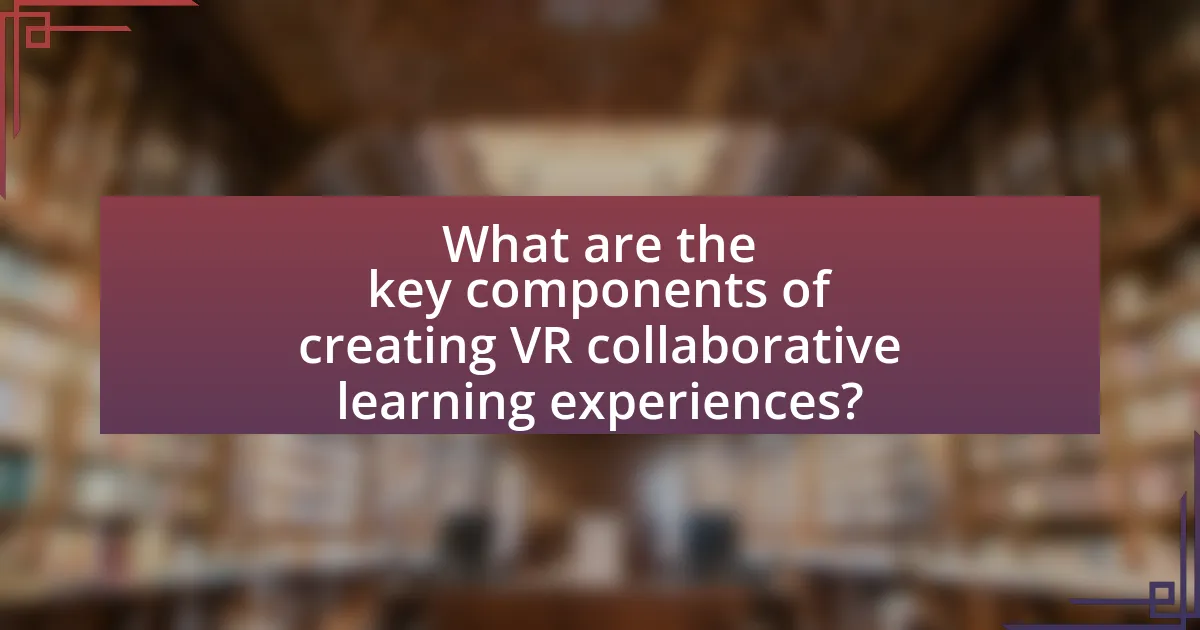
What are the key components of creating VR collaborative learning experiences?
The key components of creating VR collaborative learning experiences include immersive environments, interactive tools, social presence, and effective instructional design. Immersive environments allow learners to engage in realistic simulations, enhancing their understanding of complex concepts. Interactive tools, such as virtual whiteboards and shared resources, facilitate collaboration and communication among participants. Social presence is crucial, as it fosters a sense of community and connection, making interactions feel more authentic. Effective instructional design ensures that learning objectives are met through structured activities and assessments, promoting engagement and knowledge retention. These components collectively enhance the effectiveness of VR as a medium for collaborative learning.
What design principles should be considered for VR learning environments?
Effective design principles for VR learning environments include immersion, interactivity, user-centered design, and social presence. Immersion enhances engagement by creating a realistic and captivating experience, which is crucial for effective learning. Interactivity allows learners to manipulate virtual objects and environments, fostering active participation and deeper understanding. User-centered design focuses on tailoring experiences to the needs and preferences of learners, ensuring accessibility and usability. Social presence facilitates collaboration and communication among users, which is essential for creating a sense of community and enhancing collaborative learning experiences. Research indicates that these principles significantly improve learning outcomes in VR settings, as evidenced by studies demonstrating increased retention and engagement in immersive environments.
How do user interface and experience impact collaboration in VR?
User interface and experience significantly impact collaboration in VR by influencing user engagement, communication efficiency, and overall effectiveness of collaborative tasks. A well-designed user interface enhances usability, allowing participants to navigate virtual environments intuitively, which fosters seamless interaction. For instance, studies show that intuitive controls and clear visual cues can reduce cognitive load, enabling users to focus on collaboration rather than struggling with the technology. Additionally, immersive experiences that prioritize user experience can enhance social presence, making interactions feel more natural and encouraging teamwork. Research indicates that environments designed with user feedback in mind lead to higher satisfaction and productivity among users, ultimately improving collaborative outcomes in VR settings.
What role does feedback play in VR collaborative learning?
Feedback plays a crucial role in VR collaborative learning by enhancing communication, improving understanding, and fostering engagement among participants. In virtual environments, immediate feedback allows learners to adjust their actions and strategies in real-time, which is essential for effective collaboration. Research indicates that timely feedback can significantly increase learning outcomes, as it helps learners identify areas for improvement and reinforces positive behaviors. For instance, a study published in the Journal of Educational Technology & Society found that learners who received regular feedback in VR settings demonstrated higher levels of collaboration and knowledge retention compared to those who did not receive feedback. This evidence underscores the importance of feedback in optimizing the collaborative learning experience in virtual reality.
What types of activities can be implemented in VR for collaborative learning?
Virtual reality (VR) can implement various activities for collaborative learning, including immersive simulations, virtual field trips, and interactive problem-solving tasks. Immersive simulations allow learners to engage in realistic scenarios, enhancing teamwork and communication skills. Virtual field trips enable groups to explore distant locations together, fostering shared experiences and discussions. Interactive problem-solving tasks encourage participants to collaborate on challenges, promoting critical thinking and collective decision-making. These activities leverage VR’s capabilities to create engaging, interactive environments that enhance collaborative learning outcomes.
How can simulations be used to foster collaboration in VR?
Simulations can foster collaboration in VR by creating immersive environments where users can interact, communicate, and solve problems together in real-time. These virtual simulations allow participants to engage in shared tasks, enhancing teamwork and collective decision-making. For instance, studies have shown that VR simulations in educational settings improve group dynamics and learning outcomes, as participants can visualize complex scenarios and collaborate effectively. Research conducted by the University of Maryland found that VR-based simulations significantly increased engagement and cooperation among students, demonstrating the effectiveness of this approach in promoting collaborative learning experiences.
What group projects are effective in a VR setting?
Effective group projects in a VR setting include collaborative design tasks, virtual simulations, and immersive storytelling experiences. Collaborative design tasks allow participants to work together in a shared virtual space, enhancing creativity and teamwork. Virtual simulations, such as role-playing scenarios or problem-solving exercises, enable groups to engage in realistic situations that require collective decision-making. Immersive storytelling experiences encourage participants to co-create narratives, fostering communication and collaboration. Research indicates that these types of projects improve engagement and learning outcomes, as evidenced by studies showing increased retention rates and enhanced problem-solving skills in VR environments.

What challenges exist in creating collaborative learning experiences through VR?
Creating collaborative learning experiences through VR faces several challenges, including technological limitations, user accessibility, and social interaction dynamics. Technological limitations arise from the need for high-quality hardware and software, which can be cost-prohibitive and may not be widely available. User accessibility issues include the requirement for users to have compatible devices and a certain level of technical proficiency, which can exclude some learners. Additionally, social interaction dynamics can be hindered by the lack of non-verbal cues and the potential for disconnection among participants, which can affect engagement and collaboration. These challenges highlight the complexities involved in effectively implementing VR for collaborative learning.
What technical barriers must be overcome for effective VR collaboration?
Effective VR collaboration requires overcoming several technical barriers, including latency issues, hardware limitations, and interoperability challenges. Latency can disrupt real-time interactions, making it difficult for users to communicate and collaborate effectively; studies show that latency above 20 milliseconds can significantly impair user experience. Hardware limitations, such as the need for high-performance computing and advanced VR headsets, can restrict accessibility and usability for participants. Additionally, interoperability challenges arise when different VR platforms and systems do not communicate seamlessly, hindering collaborative efforts across diverse technologies. Addressing these barriers is crucial for enhancing the effectiveness of VR collaboration in educational settings.
How can connectivity issues affect collaborative experiences?
Connectivity issues can significantly disrupt collaborative experiences by causing delays, interruptions, and loss of data during virtual interactions. These disruptions hinder real-time communication and collaboration, leading to frustration among participants and decreased productivity. For instance, a study by the International Journal of Human-Computer Interaction found that latency in virtual environments can reduce user engagement and satisfaction, ultimately affecting the overall effectiveness of collaborative tasks. Additionally, unreliable connections can result in participants missing critical information or failing to contribute effectively, which undermines the collaborative learning objectives intended in virtual reality settings.
What are the limitations of current VR technology in education?
Current VR technology in education has several limitations, including high costs, limited accessibility, and potential for motion sickness. The expense of VR hardware and software can be prohibitive for many educational institutions, hindering widespread adoption. Additionally, not all students have access to the necessary technology at home, creating disparities in learning opportunities. Furthermore, some users experience motion sickness or discomfort while using VR, which can detract from the learning experience. According to a study published in the Journal of Educational Technology & Society, these factors significantly impact the effectiveness and integration of VR in educational settings.
How can educators address the challenges of VR collaborative learning?
Educators can address the challenges of VR collaborative learning by implementing structured guidelines and providing adequate training for both students and instructors. Structured guidelines help establish clear objectives and roles within the VR environment, which can mitigate confusion and enhance collaboration. Additionally, training ensures that all participants are familiar with the technology and its functionalities, reducing technical barriers that may hinder effective interaction. Research indicates that when educators incorporate these strategies, student engagement and learning outcomes improve significantly, as evidenced by a study published in the Journal of Educational Technology & Society, which found that well-defined roles in VR settings led to a 30% increase in collaborative task completion rates.
What strategies can be employed to enhance user engagement in VR?
To enhance user engagement in VR, interactive and immersive experiences should be prioritized. Incorporating elements such as gamification, social interaction, and personalized content can significantly increase user involvement. For instance, research by Slater et al. (2013) demonstrated that users who engaged in collaborative tasks within VR environments reported higher levels of presence and satisfaction. Additionally, providing real-time feedback and adaptive learning paths can cater to individual user needs, further boosting engagement. These strategies leverage the unique capabilities of VR to create compelling and participatory learning experiences.
How can training be provided to educators for effective VR implementation?
Training for educators in effective VR implementation can be provided through structured professional development programs that focus on hands-on experience and pedagogical strategies. These programs should include workshops that allow educators to explore VR tools, develop lesson plans, and collaborate with peers to share best practices. Research indicates that immersive training experiences significantly enhance educators’ confidence and competence in using technology, as evidenced by a study published in the Journal of Educational Technology & Society, which found that 85% of participants reported improved teaching effectiveness after VR training.
What best practices should be followed when implementing VR collaborative learning?
To implement VR collaborative learning effectively, it is essential to prioritize user engagement and interaction. Engaging users through immersive experiences enhances motivation and retention of information. Research indicates that active participation in VR environments can lead to a 75% increase in learning outcomes compared to traditional methods. Additionally, ensuring that the VR platform is user-friendly and accessible for all participants fosters inclusivity and encourages collaboration. Providing clear instructions and support during the learning process further enhances the effectiveness of the experience. Lastly, incorporating feedback mechanisms allows learners to reflect on their experiences and improve their skills, which is crucial for collaborative learning success.
How can feedback mechanisms be integrated into VR learning experiences?
Feedback mechanisms can be integrated into VR learning experiences by utilizing real-time analytics and interactive assessments. These mechanisms allow learners to receive immediate responses to their actions, enhancing engagement and understanding. For instance, VR platforms can track user performance and provide tailored feedback based on specific actions taken within the virtual environment, such as completing tasks or collaborating with peers. Research indicates that immediate feedback significantly improves learning outcomes, as evidenced by a study published in the Journal of Educational Psychology, which found that students who received timely feedback in immersive environments demonstrated a 20% increase in retention rates compared to those who did not.
What are the key considerations for assessing collaborative learning in VR?
Key considerations for assessing collaborative learning in VR include the evaluation of social presence, engagement levels, and the effectiveness of communication among participants. Social presence refers to the degree to which participants feel connected and involved with each other in the virtual environment, which can be measured through user feedback and interaction metrics. Engagement levels can be assessed by analyzing participation rates, task completion, and the quality of interactions, indicating how invested learners are in the collaborative process. Effective communication can be evaluated through the clarity and frequency of exchanges among participants, as well as the use of collaborative tools within the VR platform. These considerations are essential for understanding the impact of VR on collaborative learning outcomes and ensuring that the learning experience is both meaningful and productive.
